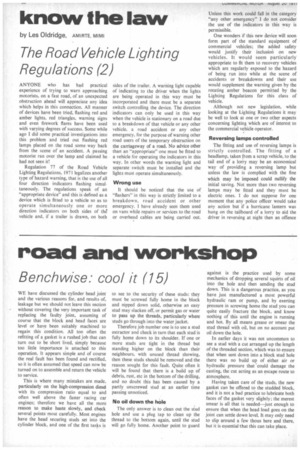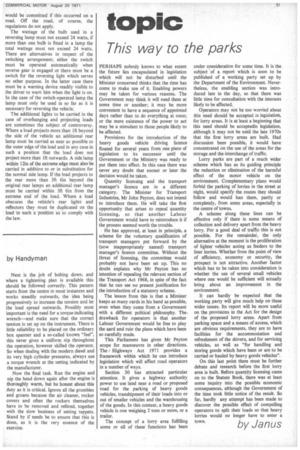know the law
Page 32

Page 33

If you've noticed an error in this article please click here to report it so we can fix it.
by Les Oldridge, AMIRTE, MIMI
The Road Vehicle Lighting Regulations (2)
ANYONE who has had practical experience of trying to warn approaching motorists, on a fast road, of an unexpected obstruction ahead will appreciate any idea which helps in this connection. All manner of devices have been tried, flashing red and amber lights, red triangles, warning signs and even firework flares have been used with varying degrees of success. Some while ago I did some practical investigations into this problem and tried out flashing red lamps placed on the road someway back from the scene of an accident. A passing motorist ran over the lamp and claimed he had not seen it!
Regulation 77 of the Road Vehicle Lighting Regulations, 1971 legalizes another type of hazard warning, that is the use of all four direction indicators flashing simultaneously. The regulations speak of an "appropriate device" and this is defined as a device which is fitted to a vehicle so as to operate simultaneously one or more direction indicators on both sides of the vehicle and, if a trailer is drawn, on both
sides of the trailer. A warning light capable of indicating to the driver when the lights are being operated in this way must be incorporated and there must be a separate switch controlling the device. The direction indicators can only be used in this way when the vehicle is stationary on a road due to a breakdown of that vehicle or any other vehicle, a road accident or any other emergency. for the purpose of warning other road users of the temporary obstruction on the carriageway of a road. No advice other than an "appropriate" one must be fitted to a vehicle for operating the indicators in this way. In other words the warning light and separate switch must be installed and the lights must operate simultaneously.
Wrong use
It should be noticed that the use of "flashers" in this way is strictly limited to a breakdown, road accident or other emergency. I have already seen them used on vans while repairs or services to the road or overhead cables are being carried out. Unless this work could fall in the category "any other emergency" I do not consider the use of the indicators in this way is permissible.
One wonders if this new device will soon form part of the standard equipment of commercial vehicles; the added safety would justify their inclusion on new vehicles. It would seem particularly appropriate to fit them to recovery vehicles which are regularly exposed to the hazard of being run into while at the scene of accidents or breakdowns and their use would supplement the warning given by the rotating amber beacon permitted by the Lighting Regulations for this class of vehicle.
Although not new legislation, while looking at the Lighting Regulations it may be well to look at one or two other aspects concerning lighting which are of interest to the commercial vehicle operator.
Reversing lamps controlled
The fitting and use of reversing lamps is strictly controlled. The fitting of a headlamp, taken from a scrap vehicle, to the tail end of a lorry may be an economical way of providing a reversing lamp but unless the law is complied with the fine which may be imposed could nullify the initial saving. Not more than two reversing lamps may be fitted and they must be electric ones. I do not suppose for one moment that any police officer would take any action but if a hurricane lantern was hung on the tailboard of a lorry to aid the driver in reversing at night then an offence would be committed if this occurred on a road, Off the road, of course, the regulations do not apply.
The wattage of the bulb used in a reversing lamp must not exceed 24 watts, if more than one bulb is fitted in a lamp the total wattage must not exceed 24 watts. There are alternatives in respect of the switching arrangement; either the switch must be operated automatically when reverse gear is engaged or there must be a switch for the reversing light which serves no other purpose. In the latter case there must be a warning device readily visible to the driver to warn him when the light is on. In the case of the switch-operated lamp the lamp must only be used in so far as it is necessary for reversing the vehicle.
The additional lights to be carried in the case of overhanging and projecting loads are sometimes the subject of controversy. Where a load projects more than 1ft beyond the side of the vehicle an additional rear lamp must he carried as near as possible to the outer edge of the load and in any case in such a position that the load does not project more than 1ft outwards. A side lamp within 12in of the extreme edge must also be carried in addition to or in substitution for the normal side lamp, lithe load projects to the rear more than 31t fin beyond the original rear lamps an additional rear lamp must be carried within 3ft 6in from the extreme end of the load. Where a load obscures the vehicle's rear lights and reflectors they must be duplicated on the toad in such a -prDsition as to comply with the law.




















































































